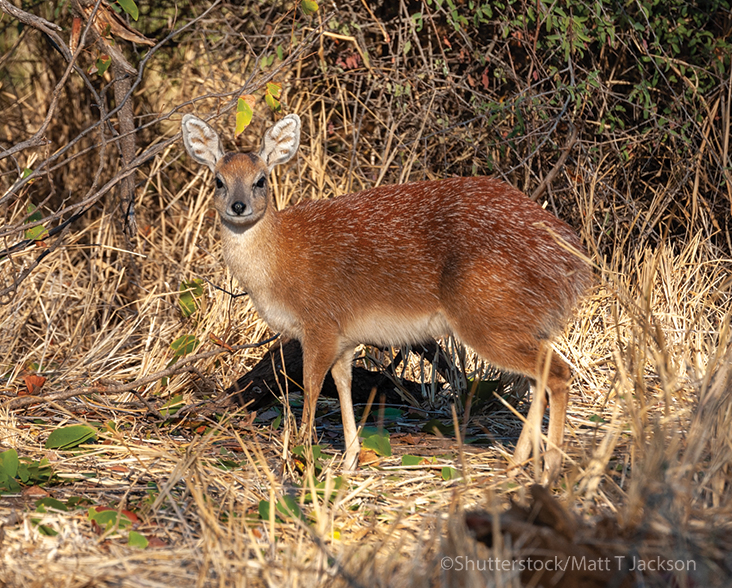Suni
Species Data
Class: Mammalia
Order: Artiodactyla
Family: Bovidae
Scientific Name: Nesotragus moschatus
IUCN Red List status: Least Concern
Description
A tiny, compact antelope with relatively high hindquarters and a short neck, the Suni reaches just 35 cm high at the shoulder and weighs 5 kg. The upperparts are rich rufous-brown with fine white flecks, and the chin, throat, underparts and inside of the legs are whitish to pale grey. The head is broad, and the naked, pinkish, semi-transparent oval ears have white hairs along the upper inner margin. Large preorbital face glands produce a pungent, musky secretion, and surrounding each eye is a white ring of almost bare skin, with a row of long, stiff hairs above and others on the snout. The legs are long and slender, the feet black or dark brown, and the hooves small, glossy and black. The 12 cm long tail is black to dark brown on the outer surface, white below, and habitually flicked from side to side. Rams have black, transversely ridged horns 6.5-13.3 cm in length and sloping backwards in line with the profile of the face. They live up to 10 years in captivity.
Behaviour
This shy and secretive species is primarily nocturnal but active also in the evenings, passing the heat of the day sleeping in the shade and hiding from predators such as Crowned Eagles, big cats and snakes. Sunis have a high metabolic rate and browse in an alert posture with their head raised in short bursts interspersed with rests on leaves, shoots and flowers of understorey plants such as Crotalaria, Acacia and Clematis as well as dry leaf litter. Suni are also known to associate with Zanzibar Sykes’ Monkeys and Zanzibar Red Colobus, feeding on dropped fruit. This species is not dependent on water sources, receiving all the moisture they need from their diet.
Sunis are usually solitary or found in pairs but also occur in groups consisting of an adult male accompanying 1-4 females. Pairs or family groups have territories of around 3 ha (7.4 acres), with both sexes marking the boundary of their territory with preorbital gland secretions, urine and dung. Male territories are well-defined, have little overlap, and are defended from other males by chasing them away while trying to strike with their horns. Female territories are usually within the territory of a male. When meeting, Sunis will touch noses and sniff facial glands, with males sometimes licking the face of their preferred female.
Breeding occurs in most months of the year. When a female comes into oestrus, she will raise and wag her tail while the male follows her closely around. Females give birth standing up to a single young after a gestation period of six months. Newborns are darker in colour than adults and hide in dense vegetation, emerging to feed only when hearing their mother’s faint calls. Young begin nibbling at vegetation at just a few days old and chewing at around a month before being weaned after about two months. Females reach sexual maturity at around one year, and males at 14 months, the territorial male chasing away young males when they begin developing horns at 6-8 months. Young females may remain with their parents when reaching adulthood.


Habitat
Sunis inhabit thickets, forests, dense woodlands and riparian reed scrub in coastal regions from sea level up to 2700 m. The highest population densities occur where there is a thick shrub layer, especially in forests bordering the foothills of mountain ranges and woodland on coral rag and sand dunes, and they are least abundant in montane forests dominated by cedar. They will also move into degraded forests.
This African species is found exclusively in coastal regions from south-eastern Kenya to KwaZulu-Natal in north-eastern South Africa. They are also present on the island of Zanzibar, Mafia and Chapani off Tanzania and have been introduced to Mnemba Island off Zanzibar as well as Rubondo Island in Lake Victoria.
Threats and Conservation
In 1999, the total Suni population was estimated at 365,000 individuals. Although the shy habits of this species make population estimates difficult, Sunis remain widespread across much of their range, and the overall population trend is thought to be stable. Therefore, this species is categorised as Least Concern on the IUCN Red List. However, in some parts of their range, numbers and population densities have declined due to habitat loss caused by expanding agriculture, and in the southern part of their range, a reduction in shrub due to browsing of an overpopulation of Nyalain. In Kenya and South Africa, where the Suni is listed as Endangered, overhunting for bushmeat and sport using dogs, nets, and snares has reduced numbers and population densities near settlements and likely over much of their range.
